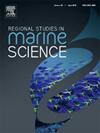Species composition and long-term dynamics of coral reef fishes at Meiji Reef, Nansha Islands
IF 2.4
4区 环境科学与生态学
Q3 ECOLOGY
引用次数: 0
Abstract
Meiji Reef, in the east-central Spratly Islands, is a typical coral reef ecosystem with high fish biodiversity. To investigate fish community dynamics, we integrated multiple survey methods (longlining, hand-lining, drift gillnetting, dive fishing, and eDNA) with historical records (1998–1999, 2004, 2012, 2016–2019) and field surveys (2020–2024). The objectives were to characterize community composition, reveal long-term changes from 1998 to 2024, and assess succession following island reclamation. This integrated dataset enabled a systematic analysis of evolutionary trends in fish community structure at Meiji Reef. As of 2024, a total of 353 coral reef fish species have been documented, classified into 162 genera, 61 families, and 14 orders. Small fishes (43.81 %) and carnivorous fishes (74.92 %) dominated the community. We found a marked decline in the number of large carnivorous fish species since the 1998–1999 surveys, alongside an increase in the proportion of small carnivorous fishes and an overall reduction in mean length and weight of carnivorous fishes. The similarity coefficients for carnivorous fish species across different periods were consistently low, categorized as either "very dissimilar" or "dissimilar," indicating substantial community turnover. However, during the 2020–2024 period, the proportions of large carnivorous fishes and reef-dependent taxa, such as the Serranidae family, notably increased compared to 2016–2019, whereas proportions of smaller carnivorous species and taxa less dependent on live coral habitats, such as Sheepfishes (Labridae), decreased significantly. These findings suggest a gradual recovery of fish resources following reef reclamation, with increases in large carnivores and coral-associated taxa, and declines in non-coral-dependent taxa. Continuous long-term monitoring is essential for elucidating fish community succession patterns and is critically important for promoting the health and resilience of coral reef ecosystems.
南沙美济礁珊瑚礁鱼类种类组成及长期动态
明治礁位于南沙群岛中东部,是典型的鱼类生物多样性较高的珊瑚礁生态系统。为了研究鱼类群落动态,我们将多种调查方法(延绳钓、手钓、漂刺网、潜水捕捞和eDNA)与历史记录(1998-1999年、2004年、2012年、2016-2019年)和实地调查(2020-2024年)相结合。目的是表征群落组成,揭示1998年至2024年的长期变化,并评估填岛后的演替。该综合数据集能够系统地分析明治礁鱼类群落结构的进化趋势。截至2024年,共有353种珊瑚礁鱼类被记录在案,分为162属,61科,14目。以小鱼(43.81 %)和食肉鱼(74.92 %)为主。我们发现,自1998-1999年调查以来,大型食肉鱼类的数量明显减少,而小型食肉鱼类的比例增加,食肉鱼类的平均长度和重量总体上都有所减少。不同时期食肉鱼类物种的相似系数一直很低,分为“非常不相似”或“不相似”,表明存在大量的群落更替。然而,在2020-2024年期间,与2016-2019年相比,大型食肉鱼类和依赖珊瑚礁的分类群(如Serranidae科)的比例显著增加,而较小的食肉鱼类和不依赖活珊瑚栖息地的分类群(如sheepfish (Labridae))的比例显著下降。这些发现表明,在珊瑚礁填海之后,鱼类资源逐渐恢复,大型食肉动物和与珊瑚相关的类群增加,而非依赖珊瑚的类群减少。持续的长期监测对阐明鱼类群落演替模式至关重要,对促进珊瑚礁生态系统的健康和复原力至关重要。
本文章由计算机程序翻译,如有差异,请以英文原文为准。
求助全文
约1分钟内获得全文
求助全文
来源期刊

Regional Studies in Marine Science
Agricultural and Biological Sciences-Ecology, Evolution, Behavior and Systematics
CiteScore
3.90
自引率
4.80%
发文量
336
审稿时长
69 days
期刊介绍:
REGIONAL STUDIES IN MARINE SCIENCE will publish scientifically sound papers on regional aspects of maritime and marine resources in estuaries, coastal zones, continental shelf, the seas and oceans.
 求助内容:
求助内容: 应助结果提醒方式:
应助结果提醒方式:


